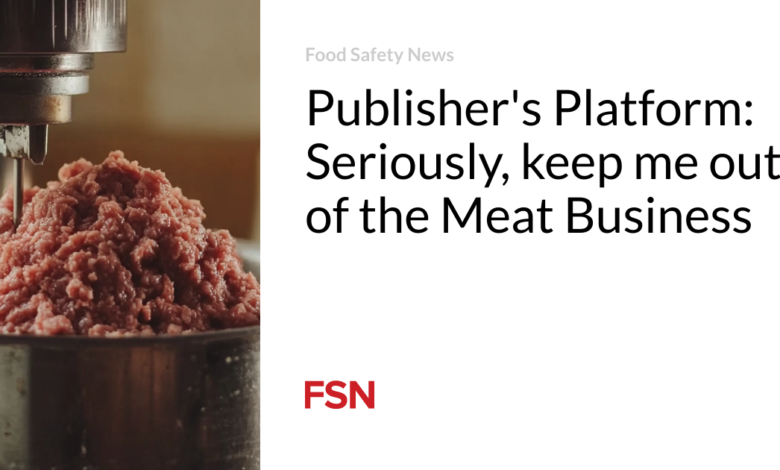Publisher’s Platform: Seriously, keep me out of the Meat Business

In 1994, in response to an E. coli outbreak linked to ground beef sold at Jack in the Box restaurants, FSIS established an E. coli sampling program which treated E. coli as an adulterant. Shortly thereafter, in the case Texas Food Industry Association v. Espy, 870 F. Supp. 143 (W.D. Tex. 1994), supermarkets and meat industry organizations challenged FSIS’s authority to establish the sampling program. The plaintiffs argued FSIS did not have the authority to treat E. coli as an adulterant under the FMIA because E. coli contaminated ground beef “is only injurious to health if improperly cooked.” The court disagreed and found that “in light of common cooking practices of most Americans, there is at least a rational basis for treating E. coli differently than other pathogens” and that “many Americans consider ground beef to be properly cooked rare, medium rare, or medium.” However, E. coli in ground beef is usually only killed off when cooked medium-well to well done. Ultimately, the court held that because E. coli “is a substance that renders ‘injurious to health’ what many Americans believe to be properly cooked ground beef” E. coli in ground beef “fits the definition of an adulterant under the FMIA.”
Also, after the Jack in the Box E. coli outbreak, requirements for cooking hamburgers in restaurants were upgraded in the FDA Food Code. Here are the long standing, key requirements related to cooking hamburgers in a restaurant setting:
- Minimum Internal Temperature: Ground beef, including hamburgers, must be cooked to a minimum internal temperature of 155°F (68°C). This temperature is critical for ensuring that harmful bacteria, such as E. coli and Salmonella, are effectively killed.
- Food Thermometers: It is essential for food establishment staff to use food thermometers to accurately check the internal temperature of hamburger patties. This ensures that the meat has reached the necessary temperature for safe consumption.
- Consistency and Monitoring: Restaurants should have procedures in place to consistently monitor and document cooking temperatures to ensure compliance with food safety standards.
- Rest Period: While not explicitly required, allowing cooked hamburgers to rest briefly after cooking can help enhance food safety by allowing residual heat to further kill any remaining pathogens.
- Training and Compliance: Food service employees should be trained in food safety practices, including proper cooking temperatures, to ensure compliance with health regulations.
Because of those two changes – E. coli as an adulterant and increasing cook temperatures – Marler Clark went from representing people sickened from tainted, undercooked hamburgers to nearly zero. The industry, with a nudge from the government, put me out of the beef business.
However, 2024 showed an alarming uptick in E. coli cases linked to ground beef and the undercooking of hamburgers in restaurant settings – not a good way to keep me out of the beef business. Here are the two examples:
At least 19 people in Minnesota were sickened by E. coli O157:H7 tied to a national recall of more than 167,000 pounds of potentially tainted ground beef. FSIS was notified of illnesses on November 13, 2024, and working in conjunction with Minnesota Departments of Agriculture and Health, FSIS determined that there was a link between the ground beef products from Wolverine Packing Co. and this illness cluster. On November 20, 2024, a ground beef sample collected by the Minnesota Department of Agriculture as part of an outbreak investigation tested positive for E. coli O157. To date, case-patients have been identified in Minnesota with illness onset dates ranging from November 2, 2024, to November 10, 2024. The infections occurred in people who had eaten hamburgers at Red Cow restaurants in the Minneapolis and Rochester areas, as well as the Hen House Eatery in Minneapolis.
A cluster of E. coli O157:H7 was investigated by the Montana Department of Public Health and Human Services, the Montana Department of Livestock, and Flathead County Health Department, along with the Centers for Disease Control and Prevention (CDC) in the summer of 2024. The investigation revealed reason to believe that ground beef product from Lower Valley Processing (LVP) entered commerce while adulterated with Escherichia coli O157:H7. In total, 22 cases were identified in this outbreak from 10 states (AZ, CA, FL, ID, MN, MO, MS, MT, OR, and VA). Six hospitalizations, three cases of HUS, and one death were reported. All specimen isolates were found to be nearly indistinguishable by cgMLST analysis (0-1 alleles different), indicating a common source of infection. All isolates were found to have the same allele code: EC1.0 ‐ 9.1.3.70x and were positive for Shiga toxin 2 (a and c). Several of these individuals were linked to the Fathead County area. Cases reported exposures to Wagyu beef burgers from the following locations: Gunsight Saloon (n=5), Harbor Grill (n=2), Tamarack (n=3), Hopps (n=2), and Whitefish Lodge (n=1). One case from Oregon did not share restaurant information with investigators. The investigation established an epidemiological connection between the affected individuals and Wagyu beef hamburger patties processed at Lower Valley Processing (LVP) and labeled as Lot 1400. Public health officials confirmed that the patties came from producer Range/Lazy K Ranch. They also discovered that this producer sells to retailer Flathead Fish & Seafood Co. in Kalispell, and that the retailer was in possession of product from Lot 1400. Two other facilities also received Lot 1400 Wagyu beef: Flathead Lake Lodge, Crawdad Café (Lake Co).
There have been several significant meat recalls in the United States caused by bacterial contamination. These recalls often involve large amounts of meat that are pulled from the market due to the risk of foodborne illnesses. Here are some of the largest meat recalls caused by bacterial contamination:
1. Westland/Hallmark Meat Co. (2008): This recall involved 143 million pounds of beef, making it one of the largest recalls in U.S. history. The recall was prompted by concerns over E. coli and was significant because it included 37 million pounds supplied to various federal nutrition programs.
2. Hudson Foods Co. (1997): Around 25 million pounds of ground beef were recalled due to potential contamination with E. coli O157:H7. The recall was prompted by reports of several E. coli infections associated with the consumption of hamburgers made from this beef.
3. Pilgrim’s Pride (2002): Approximately 27.4 million pounds of poultry products were recalled due to potential contamination with Listeria monocytogenes. This impacted various turkey and chicken products and led to increased scrutiny of meat processing practices.
4. ConAgra Beef Co. (2002): ConAgra Beef Co. recalled 19 million pounds of ground beef due to possible contamination with E. coli O157:H7. The announcement followed reports of illnesses linked to the tainted beef, prompting the recall.
5. Cargill Meat Solutions (2007): Cargill initiated a recall of approximately 845,000 pounds of ground beef products due to concerns over E. coli O157:H7 contamination. This followed reports of illnesses associated with the beef.
6. JBS Tolleson, Inc. (2018): This recall involved about 12 million pounds of raw beef products that were potentially contaminated with Salmonella Newport. The recall was issued after several cases of salmonellosis were linked to the consumption of these products.
Recalls are a part of the broader safety measures taken to protect public health by preventing the consumption of potentially harmful food products. These recalls often involve collaboration between the producer, the U.S. Department of Agriculture (USDA), and other health agencies.
Let’s hope the past stays in the past.



